

News and Young Australians in 2020. Between February 28 and March 16 2020 we surveyed a nationally representative sample of 1,069 young Australians aged 8-16 years to understand their news engagement practices and experiences.
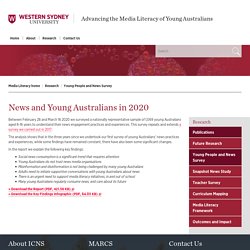
This survey repeats and extends a survey we carried out in 2017. The analysis shows that in the three years since we undertook our first survey of young Australians’ news practices and experiences, while some findings have remained constant, there have also been some significant changes. Who tells your story on Wikipedia. Growing up, my father was the storyteller of our family.

He would use stories to encourage me, to remind me of how important it was to be proud of who I am, to teach me about our family history, and to make me laugh. This was history, but it had never been written down. Instead, it was weaved into family tales and songs, and then passed along from generation to generation. As I grew up, I learned that our family tradition of storytelling was part of our cultural legacy as Black Americans. We grew up telling stories because many of our great grandparents and great great grandparents weren’t able to or allowed to read. Media Literacy. During the period November 2019 to February 2020, we asked Australian school teachers to complete our survey about whether – and how – they teach students about news media in the classroom and 295 teachers responded.

Following this, we interviewed 20 of these survey respondents. The purpose of these interviews was to gain additional insights into teachers’ thoughts and opinions about teaching news media literacy in their classrooms. This report presents our key findings from this research. The research shows that Australian teachers believe that teaching students about news media is very important and many are already doing this regularly. However, while almost all teachers who completed our survey said they want to teach students about news media, one third of teachers are not very confident about doing so. Making sense of news – fact from fiction. Being bombarded with information from various digital media and social media platforms is a daily reality for the majority of teenagers.
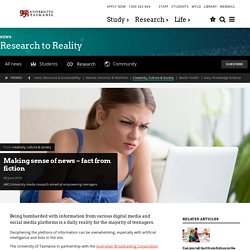
Deciphering the plethora of information can be overwhelming, especially with artificial intelligence and bots in the mix. The University of Tasmania in partnership with the Australian Broadcasting Corporation (ABC) has embarked on a media literacy project with the aim to provide an evidence based input into these very challenges. ABC Media Education Partnerships Manager, Dr Jocelyn Nettlefold, said the project is a first of its kind in Australia and hopes to empower teenagers to better navigate the complicated news and information landscape. With the rise of misinformation in the digital age, information is spread really fast and at unprecedented volumes. There are some very significant consequences emerging and all this is happening at a time of declining public trust in journalism. Why engage teenagers? Insight Five: A snapshot of Media Literacy in Australian Schools - Institute for Social Change. Media literacy snapshot shows students need help navigating the news Researchers at UTAS have identified an urgent need for greater digital media awareness and media literacy support for Australian teachers and students.

Image: Dr Jocelyn Nettlefold A new Institute for the Study of Social Change report titled Insight Five: A Snapshot of Media Literacy in Australian Schools explores the challenge of teaching young people to separate fact from fiction in an age of online news manipulation. Image: Dr Kathleen Williams. Report: Media literacy lessons a must for schools - Digital Media Research Centre. Lizard People in the Library. Enough with the CRAAP: We're just not doing it right - NeverEndingSearch.
It’s not the web it used to be and our traditional approaches to teaching about it no longer make sense.

In fact, we teach strategies that often fail our students. A new study from the Stanford History Education Group (SHEG): Educating for Misunderstanding: How Approaches to Teaching Digital Literacy Make Students Susceptible to Scammers, Rogues, Bad Actors, and Hate Mongers, reveals some of the issues. Researchers studied 263 college students at a large East Coast state university and presented them with two tasks.
The first asked students to evaluate the trustworthiness of a news story from a satirical website. Two-thirds of the students failed to recognize the article as satire. The Seattle Tribune is a news and entertainment satire web publication. . . .All news articles contained within The Seattle Tribune are fictional and presumably satirical. News Literacy Project. Sifting Through the Pandemic – Information hygiene for the Covid-19 infodemic.
Were TikTok users and K-pop fans really behind the poor turnout at Trump's Tulsa rally? - ABC News. US President Donald Trump's first campaign rally since the coronavirus pandemic received more than 1 million ticket requests.
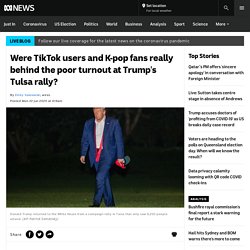
So when just over 6,000 people showed up to the event on Saturday in Tulsa, Oklahoma, many were left wondering if the poor turnout had something to do with a viral TikTok video. In the week leading up to the rally — which was originally (and controversially) scheduled for Friday, June 19 — TikTok users jumped on a trend that involved reserving tickets without having any intention of attending. How did the TikTok trend start? The original idea for the mass ticket troll appears to have come from an Iowa woman named Mary Jo Laupp. The 51-year-old posted a TikTok video on June 12 pointing out the cultural insensitivity of holding a political rally in Tulsa on a holiday known as Juneteenth. He eventually changed the event to June 20, but that didn't stop Ms Laupp's TikTok video from spreading like wildfire.
Enter: K-pop fans What was the actual turnout? How To Spot Fake News - IFLA in the post-truth society. Skip to main content You are here: Home » Activities and Groups » Information Society » News » How To Spot Fake News - IFLA in the post-truth society Search form 1 February 2017. Addressing Bias in Research Instruction. #ThinkBeforeSharing - Stop the spread of conspiracy theories. Spotting Misinformation and #FakeNews: 10 Resources To Teach Students Media Literacy. OneTab shared tabs. MEDIA LITERACY - Education. AMF Media Literacy Lab. Home. 3 ways to help children think critically about the news. Like adults, children use the news to learn about what’s happening in the world.
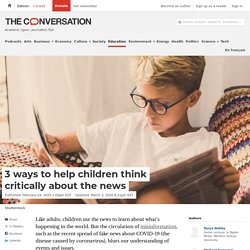
Libraries fake news. Imagine, for a moment, the technology of 2017 had existed on Jan. 11, 1964 – the day Luther Terry, surgeon general of the United States, released “Smoking and Health: Report of the Advisory Committee to the Surgeon General of the United States.”
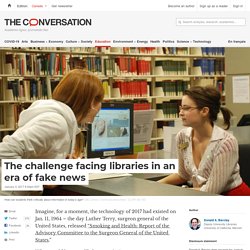
What would be some likely scenarios? The social media noise machine explodes; conservative websites immediately paint the report as a nanny-government attack on personal freedom and masculinity; the report’s findings are hit with a flood of satirical memes, outraged Facebook posts, attack videos and click-bait fake news stories; Big Tobacco’s publicity machine begins pumping out disinformation via both popular social media and pseudoscientific predatory journals willing to print anything for a price; Republican presidential candidate Barry Goldwater characterizes “Smoking and Health” as a “communist-inspired hoax.”
Eventually, the Johnson administration distances itself from the surgeon general’s controversial report. Maybe not. What's newsworthy about 'social news'? Characteristics and potential of an emerging genre. Civic Online Reasoning. Digital News Report: Australia - University of Canberra. Most Australians will miss local news if it disappears.
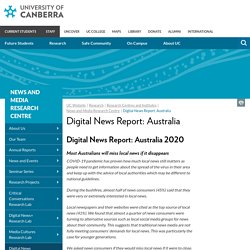
We live in an age of 'fake news'. But Australian children are not learning enough about media literacy. Today we release the findings from our new research into how young Australians consume and think about news media. Following a summer of bushfires and during the COVID-19 pandemic, young people have told us they consume news regularly. But they also say they can find it frightening and many don’t ask questions about the true source of the information they are getting. FRAMEWORK – The Australian Media Literacy Alliance. News and Young Australians in 2020. Media Literacy. Project Leads Dr. Tanya Notley, Senior LecturerSchool of Humanities and Communication Arts and Institute for Culture & Society, Western Sydney University Associate Prof Michael DezuanniAssociate Director, Digital Media Research Center, Queensland University of Technology Project Leads Dr.